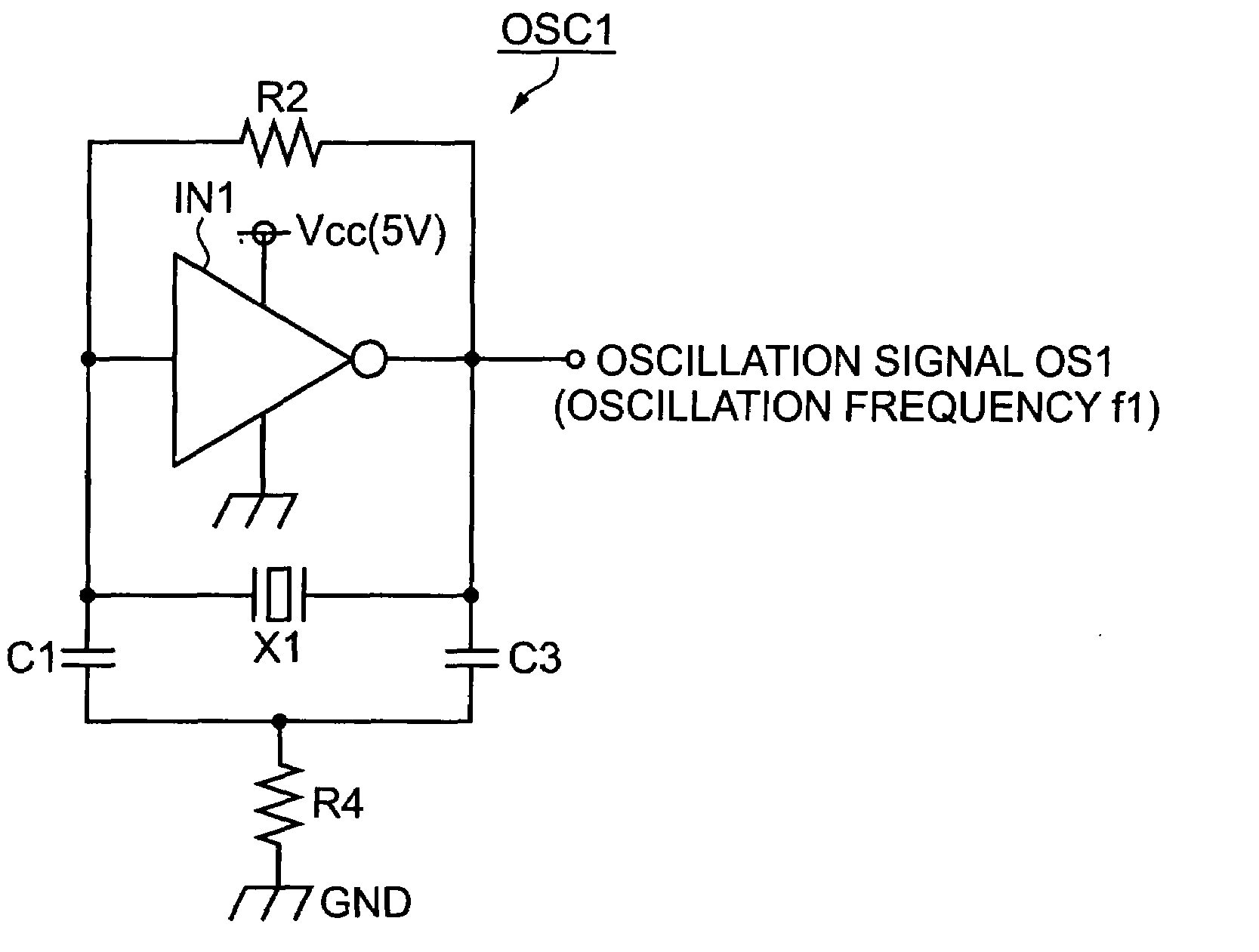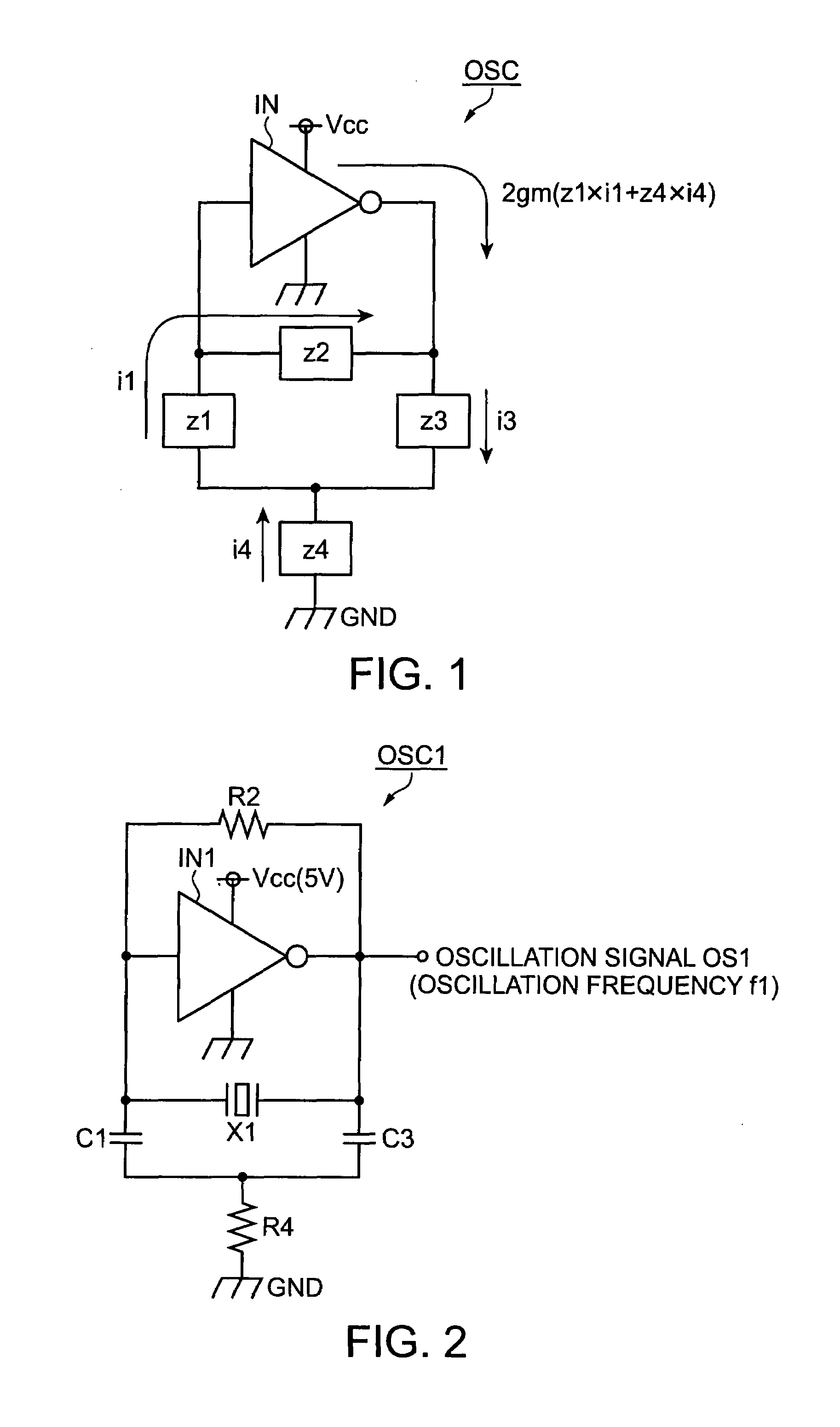Oscillation circuit
a technology of oscillating circuits and oscillating signals, applied in the direction of oscillating generators, electrical devices, etc., can solve the problems of oscillating signal os
- Summary
- Abstract
- Description
- Claims
- Application Information
AI Technical Summary
Benefits of technology
Problems solved by technology
Method used
Image
Examples
example 1
[0063]Referring to FIG. 2, an oscillation circuit OSC1 of an example 1 includes, as the inverter IN and the first to fourth impedances z1 to z4 of the oscillation circuit OSC of FIG. 1, an inverter IN1, a capacitor C1, a quartz crystal oscillator X1, a capacitor C3, and a resistor R4, and also includes a resistor R2 as a bias resistance.
[0064]The first to fourth impedances z1 to z4 are defined as shown in equations 18. When the equations 18 are substituted into the equation 12 that is the basic formula for z2=zxt, an equation 19 is given. Also, when the equation 19 is solved with respect to a circuit resistance Rc and a circuit capacitance Cc, equations 20 are given.
Equation 18z1=1jω.C1z2=zxtz3=1jω.C3z4=R4(18)Equation 19zxt+1jω.(1C1+1C3)-1ω2C1C3×112gm+R4=Rc+1jω.Cc=0(19)Equation 20Rc=-1ω2C1C3×112gm+R41Cc=1C1+1C3(20)
[0065]Pertaining to the equations 20 of the oscillation circuit OSC1 of the example 1, when a simulation is performed provided that the oscillation frequency f1 of an o...
example 2
[0067]With reference to FIG. 6, an oscillation circuit OSC2 of an example 2 includes, as the inverter IN and the first to fourth impedances z1 to z4 of the oscillation circuit OSC of FIG. 1, the inverter IN1, the quartz crystal oscillator X1, a capacitor C2, an inductor L3 and a bypass condenser Cp, and the resistor R4, and also includes the bias resistor R2.
[0068]The first to fourth impedances z1 to z4 in this case are defined as shown in equations 21. When the equations 21 are substituted into the equation 14 that is the basic formula for z1=zxt, an equation 22 is given. Also, when the equation 22 is solved with respect to the circuit resistance Rc and the circuit capacitance Cc, equations 23 and 24 are given.
Equation 21z1=zxtz2=1jω.C2z3=jω.L3ω232=1C2L3z4=R4(21)Equation 22zxt-2gm(1+2gmR4)(2gmω2ω232)+{ω.C2(1+2gmR4)}2×(1-ω2ω232)ω2ω232+1jωω2.C2(1+2gmR4)2(2gmω2ω232)2+{ω.C2(1+2gmR4)}2×(1-ω2ω232)=zxt+Rc+1jω.Cc=0(22)Equation 23Rc=-2gm(1+2gmR4)(2gmω2ω232)2+{ω.C2(1+2gmR4)}2×(1-ω2ω232)ω2...
example 3
[0071]With reference to FIG. 10, an oscillation circuit OSC3 of an example 3 includes, as the inverter IN and the first to fourth impedances z1 to z4 of the oscillation circuit OSC of FIG. 1, the inverter IN1, an inductor L1 and the bypass condenser Cp, the capacitor C2, the quartz crystal oscillator X1, and the resistor R4, and also includes the bias resistor R2.
[0072]The circuit resistance Rc and the circuit capacitance Cc of the oscillation circuit OSC3 of the example 3 are given in the equations 23 and 24, as in the case with the circuit resistance Rc and the circuit capacitance Cc of the oscillation circuit OSC2 of the example 2.
[0073]FIG. 11 shows the experimental results of the oscillation circuit of the example 3. In this experiment, the oscillation frequency f3 of an oscillation signal OS3=10 MHz, the capacitor C2=10 pF, and the inductor L1=6 μH. Referring to FIG. 11, when the resistor R4 is greater than around 2,500 Ω, the oscillation signal OS3 becomes a good sinusoidal w...
PUM
 Login to View More
Login to View More Abstract
Description
Claims
Application Information
 Login to View More
Login to View More - R&D
- Intellectual Property
- Life Sciences
- Materials
- Tech Scout
- Unparalleled Data Quality
- Higher Quality Content
- 60% Fewer Hallucinations
Browse by: Latest US Patents, China's latest patents, Technical Efficacy Thesaurus, Application Domain, Technology Topic, Popular Technical Reports.
© 2025 PatSnap. All rights reserved.Legal|Privacy policy|Modern Slavery Act Transparency Statement|Sitemap|About US| Contact US: help@patsnap.com



